Macs Wetland: A Restoration Success Story
Aiming to capitalise on the ecological benefits, Central Queensland farmer Jason Bradford embarked on a wetland remediation journey after witnessing the success achieved at Marklands Wetlands during a field day hosted by Catchment Solutions.
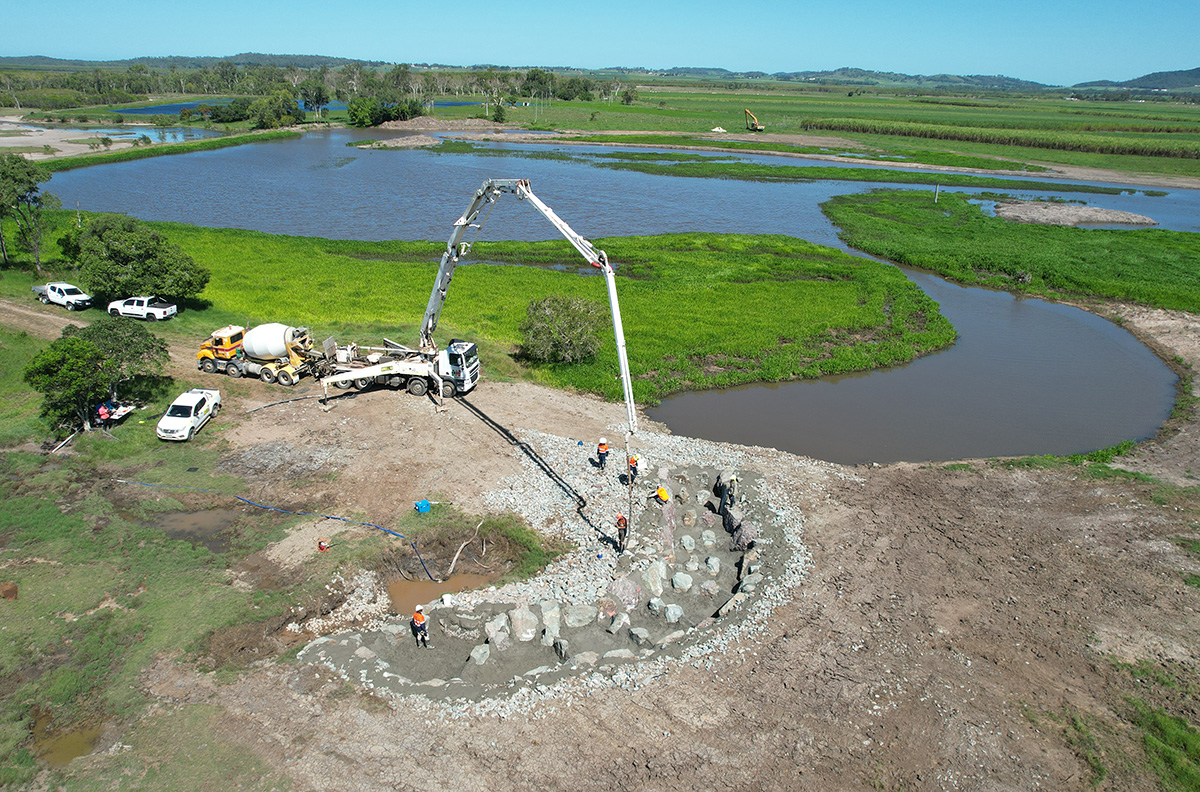
Strategic planning and rehabilitation can transform a degraded wetland ecosystem
The Macs Wetland project shows how strategic planning and rehabilitation can transform a degraded wetland ecosystem, promoting thriving fish and bird populations, while maintaining a productive farming enterprise. The successful integration of ecological restoration and grazing management demonstrates a holistic approach to farming, by applying sustainable land management that benefits both nature and agriculture.
Catchment Solutions, in partnership with Reef Catchments NRM with funding from the Australian Government’s Reef Trust program completed the rehabilitation project at Macs Wetland near Mackay, QLD in 2022-23. The project aimed to enhance wetland biodiversity values and improve water quality by addressing in-stream habitat and aquatic connectivity constraints associated with ponded pasture wetlands.
“A cattleman’s dream, but a barra’s nightmare”
Ponded pastures are shallow wetlands typically formed by constructing an earthen bund wall across a marine tidal plane or watercourse to retain freshwater run-off. The shallow wetlands are ideal for growing invasive grass species such as Hymenachne amplexicaulis, a semi-aquatic water plant originating from South America. Hymenachne, a category 3 Weed of National Significance (WoNS) is widely used in ponded pasture wetlands as cattle fodder during dry times when terrestrial grass is less prevalent (Figure 1). Although Hymenachne was introduced into ponded pastures with good intentions, it significantly impacts biodiversity, outcompeting native aquatic plants and reducing dissolved oxygen levels. The resulting anoxic conditions reduce aquatic ecosystem health and create conditions often below the tolerance limits of aquatic fauna, particularly fish.
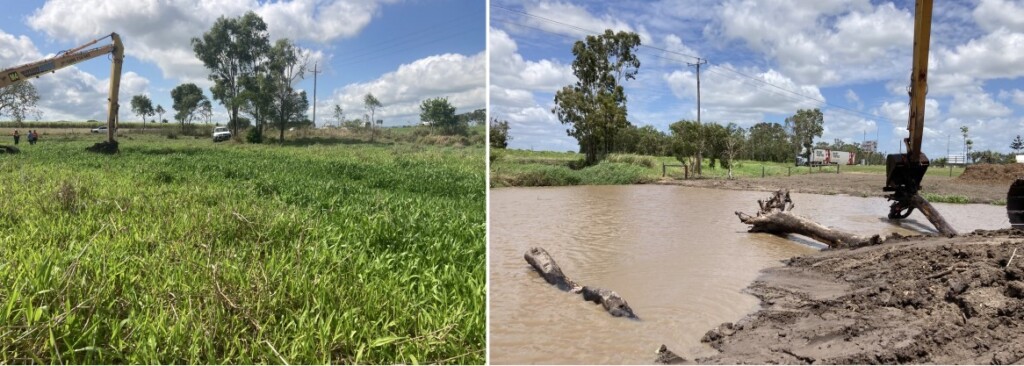
With improved management, ponded pastures can provide similar ecosystem services of natural wetlands. Flows emanating out of coastal ponded pastures attract many iconic fish species such juvenile barramundi, giant herring and tarpon. These species undertake life-cycle dependent migrations between saltwater habitats and coastal freshwater wetlands which they utilise as nursery habitats. However, the shallow characteristics of ponded pastures in-conjunction with low dissolved oxygen levels significantly inhibit the ability of these wetlands to provide suitable year-round habitat (e.g., refugia) and water quality conditions. Simply, fish and other many aquatic fauna require permanent water with sufficient dissolved oxygen to survive, and both these requirements are often lacking in ponded pastures.
Achieving the Balance of Grazing and Ecology
To improve wetland habitat and function, Catchment Solutions fish habitat team set about designing a coastal wetland system to provide environmental services while maintaining a productive grazing enterprise. Key goals included establishing permanent deep pool refuge habitat, improving fish passage, managing invasive Hymenachne extent, increasing riparian and in-stream habitat and ensuring no net loss of grazing production. Construction began in late 2022 during the dry season when the shallow wetland was completely empty. A long reach excavator was used to construct large refuge pools (>2.5 m) and connecting channels, utilising the excavated material to create elevated grazing areas throughout the wetland. The pools and channels were designed with steep banks and sufficient depth (>1.5 m) to reduce the ability of Hymenachne to establish rafts within the open water habitats and confine it to the shallow margins where it remains accessible for grazing.
Large hardwood logs with root balls were strategically placed in the refuge pools and channels to provide in-stream habitat complexity. Refuge pools provide many holistic benefits, including permanent dry season open water habitat, thermal refuge, improved dissolved oxygen levels and reduce the ability of Hymenachne to grow; it requires shallow water <1.2 m. Open water habitats promote wind waves, which transfer oxygen from the atmosphere into the wetland via diffusion. Finally, endemic riparian revegetation was planted within cattle exclusion fences to provide habitat, shade, and promote terrestrial connectivity.
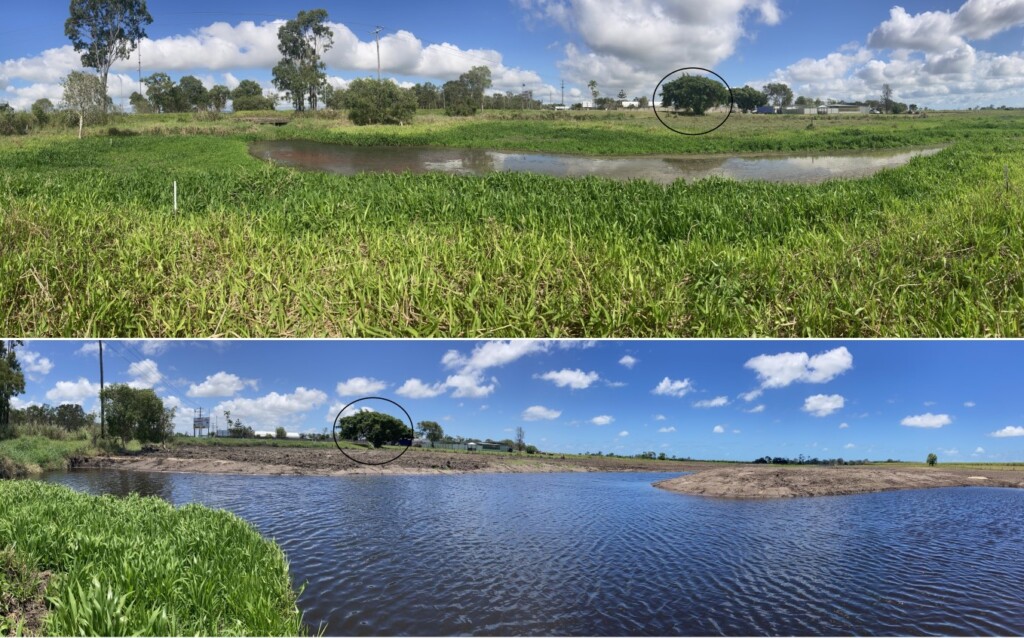
Building Bridges Between the Habitats
To establish connectivity between downstream saltwater habitats and the freshwater wetland, a rock ramp fishway was constructed to remediate a 1 m high spillway on the wetland outlet. The fishway design adopts a natural approach, taking the form of a lateral rock ramp with 11 ridges and 80 mm drops between pools. Incorporated into the fishway was a novel Nursery Slot recently designed by Catchment Solutions (Figure 3).
Preliminary monitoring results showed that the Nursery Slot can facilitate upstream fish passage for post larvae (empire gudgeon) and leptocephalus (tarpon) life -stages.
The Nursery Slot fishway may be the first fish passage design to facilitate upstream connectivity for these life-stages.
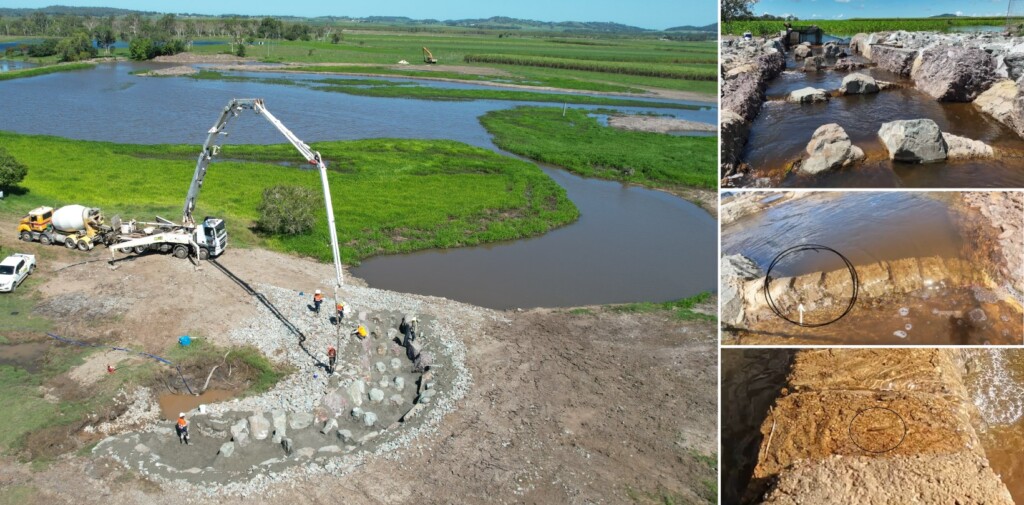
The Nursery Slot - Innovation of Design
The Nursery Slot is characterised by a series of staggered steps each 20 mm lower than the previous. This design provides a shallow film of water across a range of flow conditions. The shallow water passing over the concrete slot creates friction, creating a reduced velocity zone also known as the ‘boundary layer’. This reduced velocity zone allows weaker swimming post larvae and juvenile diadromous fish species the opportunity to migrate upstream into preferential nursery habitats.
Preliminary monitoring results showed that the Nursery Slot can facilitate upstream fish passage for post larvae (empire gudgeon) and leptocephalus (tarpon) life -stages. The Nursery Slot fishway may be the first fish passage design to facilitate upstream connectivity for these life-stages.
Click on link to see a video of the Nursery Slot fishway
Positive ecological restoration of wetlands + improved grazing management
A pipe with a manual shut-off valve was retrofitted to the bund wall to allow precise management of upstream water levels (Figure 4). The pipe allows water levels in the wetland to be reduced prior to the onset of the wet season (e.g., November-December), with the knowledge that impending stream flows will re-fill the wetland (January-February). The management of water levels allows cattle to effectively graze down Hymenachne in the channels connecting the refuge pools, reducing overall biomass, providing valuable dry season cattle fodder, and ensuring these areas remain largely Hymenachne free when the wetland re-fills. The construction of deep pools is critical component in the management of water levels, providing aquatic fauna refugia until the wetland re-fills

Thriving Aquatic Communities – Evaluation Monitoring
Fishway monitoring was conducted in April 2023 to evaluate the success of the fishway at facilitating upstream passage for migrating fish communities (Figure 5). Across three days, a total of 2,730 fish representing 13 species at a catch rate of 1,215 fish per day were successfully recorded ascending the fishway. The fish catch was dominated by diadromous species – fish which undertake life-cycle dependant migrations between saltwater and freshwater – with 8 species, including socio-economic species; barramundi, giant herring, tarpon, mullet sp., eel sp., as well as small-bodied species which play important ecological roles in freshwater ecosystems; empire gudgeon and striped scat. Post larvae and juvenile fish dominated the catch, with fish as small as 15 mm observed using the Nursery Slot.
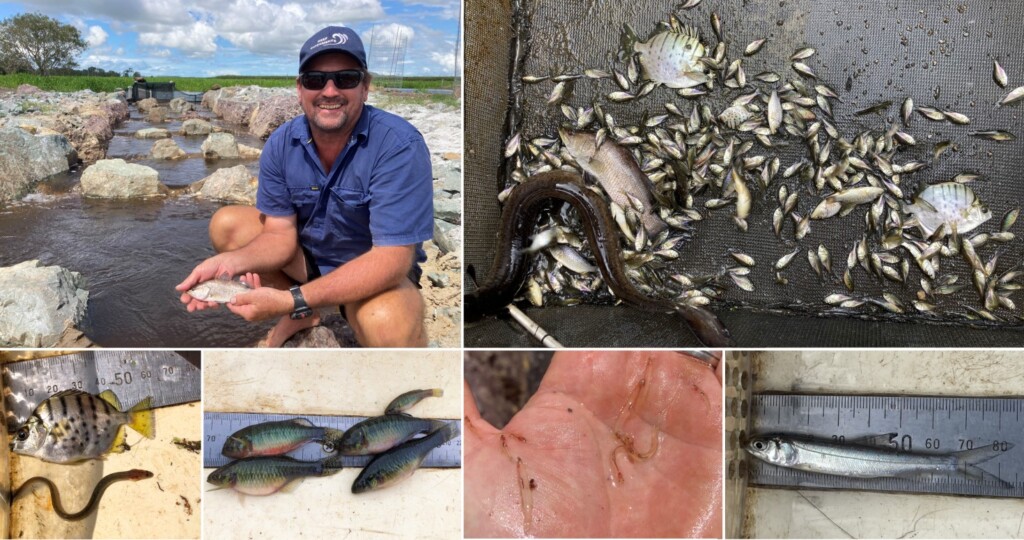
Fish community electrofishing monitoring was undertaken in June 2023 to evaluate the success of the wetlands at providing suitable habitat conditions for aquatic fauna. Results were outstanding, demonstrating the revitalised wetlands capacity to support a rich and diverse fish community, with 13 species comprising six diadromous, six potamodromous, and one invasive species recorded. This is a large increase in species richness, from zero fish six months earlier when the wetlands were completely dry. The notable presence of giant herring, a species commonly found in near shore marine habitats of the Great Barrier Reef is an indication that connectivity and water quality conditions have improved. (Figure 6). During the surveys a wide range of wetland fauna was observed including an estuarine crocodile (the 1st time they have been observed in the wetland), saw-shell turtle, jabiru, jacana and cotton-pygmy goose. Moreover, the excellent water quality, particularly evident through enhanced dissolved oxygen levels, demonstrate the benefits of improved grazing management and the creation of deep refuge pools.
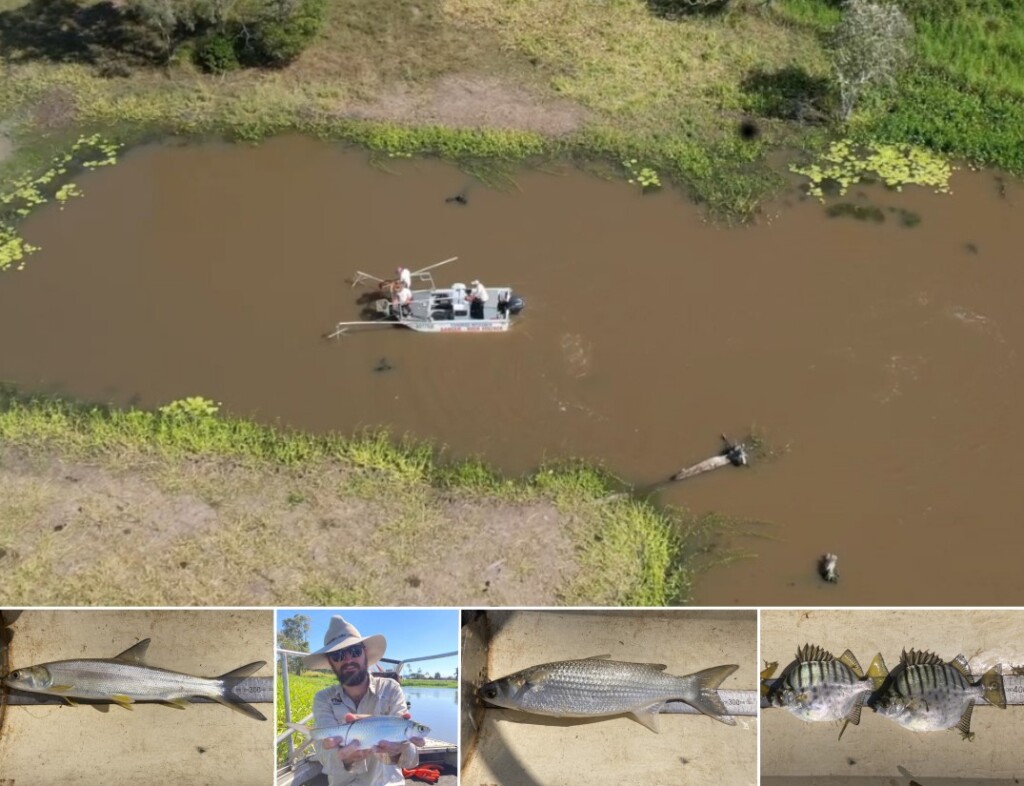
From Dry to Diverse
Over time, it’s anticipated that species richness within the wetlands will increase, particularly as endemic riparian revegetation becomes established and the benefits of improved connectivity are realised. Overall, the results demonstrate that positive ecological restoration of wetlands can occur in partnership with improved grazing management providing additional ecosystem services to benefit the environment, agriculture and local communities.